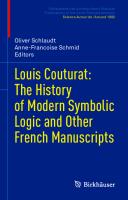Elements of Symbolic Logic
451 68 104MB
English Pages 453 (444) [453] Year 1966
Table of contents :
I. INTRODUCTION
§ 1. Logic and language
§ 2. Language
§ 3. Different levels of language
§ 4. Instrumental usage of language
§ 5. Definitions
II. THE CALCULUS OF PROPOSITIONS
§ 6. Propositional operations
§ 7. Truth tables
§ 8. Survey of possible operations. Tautologies
§ 9. Interpretation of tautological operations as connective operations
§ 10. Reduction of operations to other operations
§ 11. Derivations
§ 12. The rule of substitution
§ 13. The rule of replacement
§ 14. The rule of inference
§ 15. Secondary rules of inference
§ 16. Remarks on the method of derivation
III. THE SIMPLE CALCULUS OF FUNCTIONS
§ 17. Propositional functions
§ 18. Binding of variables
§ 19. Negation of operators
§ 20. The scope of an operator and the order of operators
§ 21. Synthetic assertions containing free argument variables
§ 22. Some concepts referring to functions
§ 23. Truth characters of one-place functions
§ 24. Definition of tautologies containing functions
§ 25. The use of case analysis for the construction of tautologies in propositional functions
§ 26. The rules of substitution and inference in the calculus of functions
§ 27. The rule for free variables
§ 28. Derivation of tautologies
§ 29. Secondary rules
§ 30. Derivations from synthetic premises
§ 31. The formal and the material conception of language
§ 32. The proof of consistency
§ 33. Two objections against the proof of consistency
§ 34. Logical evidence
V. THE CALCULUS OF CLASSES
§ 35. Classes
§ 36. The syllogism
§ 37. The principle of abstraction
§ 38. Classes of couples, triplets, and so on
VI. THE HIGHER CALCULUS OF FUNCTIONS
§ 39. Functions of higher types
§ 40. The antinomies and the theory of types
§ 41. The technique of the higher calculus
§ 42. The treatment of indefinite expressions
§ 43. The relation of identity
§ 44. The definition of number
VII. ANALYSIS OF CONVERSATIONAL LANGUAGE
§ 45. The deficiencies of traditional grammar
§ 46. Proper names
§ 47. Descriptions
§ 48. The problem of individuals
§ 49. Fictitious existence
§ 50. Token-reflexive words
§ 51. The tenses of verbs
§ 52. Classification of functions
§ 53. Functions of higher types
§ 54. Descriptional functions
§ 55. Logical terms in a syntactical capacity
§ 56. Logical terms in a semantical capacity
§ 57. Logical terms in a pragmatic capacity
§ 58. Extraneous terms
§ 59. Classification of the parts of speech
VIII. CONNECTIVE OPERATIONS AND MODALITIES
§ 60. Practical reasons for the introduction of connective operations
§ 61. Formal characterization of connective operations
§ 62. The logical nature of connective operations
§ 63. Relative nomological statements
§ 64. The semi-adjunctive implication
§ 65. Modalities
§ 66. Modal interpretation of connective operations
Exercises
Solutions
Index
I. INTRODUCTION
§ 1. Logic and language
§ 2. Language
§ 3. Different levels of language
§ 4. Instrumental usage of language
§ 5. Definitions
II. THE CALCULUS OF PROPOSITIONS
§ 6. Propositional operations
§ 7. Truth tables
§ 8. Survey of possible operations. Tautologies
§ 9. Interpretation of tautological operations as connective operations
§ 10. Reduction of operations to other operations
§ 11. Derivations
§ 12. The rule of substitution
§ 13. The rule of replacement
§ 14. The rule of inference
§ 15. Secondary rules of inference
§ 16. Remarks on the method of derivation
III. THE SIMPLE CALCULUS OF FUNCTIONS
§ 17. Propositional functions
§ 18. Binding of variables
§ 19. Negation of operators
§ 20. The scope of an operator and the order of operators
§ 21. Synthetic assertions containing free argument variables
§ 22. Some concepts referring to functions
§ 23. Truth characters of one-place functions
§ 24. Definition of tautologies containing functions
§ 25. The use of case analysis for the construction of tautologies in propositional functions
§ 26. The rules of substitution and inference in the calculus of functions
§ 27. The rule for free variables
§ 28. Derivation of tautologies
§ 29. Secondary rules
§ 30. Derivations from synthetic premises
§ 31. The formal and the material conception of language
§ 32. The proof of consistency
§ 33. Two objections against the proof of consistency
§ 34. Logical evidence
V. THE CALCULUS OF CLASSES
§ 35. Classes
§ 36. The syllogism
§ 37. The principle of abstraction
§ 38. Classes of couples, triplets, and so on
VI. THE HIGHER CALCULUS OF FUNCTIONS
§ 39. Functions of higher types
§ 40. The antinomies and the theory of types
§ 41. The technique of the higher calculus
§ 42. The treatment of indefinite expressions
§ 43. The relation of identity
§ 44. The definition of number
VII. ANALYSIS OF CONVERSATIONAL LANGUAGE
§ 45. The deficiencies of traditional grammar
§ 46. Proper names
§ 47. Descriptions
§ 48. The problem of individuals
§ 49. Fictitious existence
§ 50. Token-reflexive words
§ 51. The tenses of verbs
§ 52. Classification of functions
§ 53. Functions of higher types
§ 54. Descriptional functions
§ 55. Logical terms in a syntactical capacity
§ 56. Logical terms in a semantical capacity
§ 57. Logical terms in a pragmatic capacity
§ 58. Extraneous terms
§ 59. Classification of the parts of speech
VIII. CONNECTIVE OPERATIONS AND MODALITIES
§ 60. Practical reasons for the introduction of connective operations
§ 61. Formal characterization of connective operations
§ 62. The logical nature of connective operations
§ 63. Relative nomological statements
§ 64. The semi-adjunctive implication
§ 65. Modalities
§ 66. Modal interpretation of connective operations
Exercises
Solutions
Index

- Author / Uploaded
- Hans Reichenbach
- Similar Topics
- Other Social Sciences
- Philosophy: Critical Thinking






![Essentials of Symbolic Logic [3 ed.]
9781460404577, 1460404572](https://ebin.pub/img/200x200/essentials-of-symbolic-logic-3nbsped-9781460404577-1460404572.jpg)


